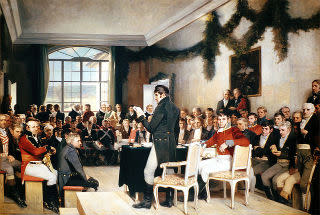Liberty rising, from Philadelphia to Eidsvoll

The Norwegian Constituent Assembly
This year, the Norwegian Constitution turns 200 years old, making it one of the oldest continuous national constitutions in the world. The U.S. Constitution, and the men who crafted it, played no small role in Norway’s deliberations.
In Red, White and Blue: Norwegian Constitution, American Inspiration, a new collection of essays exploring this important Transatlantic relationship, University of Oslo law professor Ola Mestad details the influence of American political thought and history on the 112 men who gathered in Eidsvoll on April 10, 1814.
Known as the Constituent Assembly, that prestigious group would have distantly followed news from revolutionary America as early as 1776, when word of the Declaration of Independence began to reach Europe—albeit partially censored by the powers-that-be in the Dano-Norwegian capital of Copenhagen.
The same was true 11 years later, when scattered reports emerged from the Constitutional Convention in Philadelphia. Attempting to summarize developments in presidential power, one journal declared, “General Washington has been appointed dictator of the United States for a period of four years.”
Just another decade later, law schools in Copenhagen were teaching the American Constitution, heralding concepts like representative democracy and bicameral legislatures. Even though Norway remained under the rule of a foreign king, its educated men were able to think outside their borders and consider revolutionary political ideas.
In particular, Mestad traces three major threads of influence in the final Constitution that emerged after five weeks of debate on May 14, 1814.
First, the men of Eidsvoll saw liberty as the overriding purpose of the new national document they were creating.
Unlike the American Constitution, the Norwegian Constitution doesn’t include the word “liberty” anywhere in its text—the framers saw their constitution as a practical framework with practical rules. But one draft preamble does include “liberty,” and the principles ultimately adopted echo the importance of civil and political liberties.
Second, key principles of the American Constitution also found expression in the Norwegian document.
The new constitution was drafted and adopted without any participation from the reigning Prince Christian Frederik—an act of popular sovereignty. Plus, despite retaining the monarchy, it makes clear that “the people” exercise that sovereignty through the Storting, Norway’s legislature, and that proposed amendments to the Constitution must obtain legislative approval—a division of power between the king’s executive power and the Storting’s legislative power.
Third, several provisions of the Norwegian Constitution were almost entirely lifted directly from the American version.
For example, the men of Eidsvoll divided the Storting into two chambers: the Lagting, a Senate parallel, and the Odelsting, the House’s counterpart. Notably, however, the Norwegian framework provides for the two chambers to come together for a joint vote in the case of unresolved disagreement—making today’s divided U.S. Congress less of a likelihood.
After the Constitution’s adoption in May, Sweden invaded Norway as part of the Napoleonic Wars. Despite Norway’s surrender to Sweden, its constitution survived, and survives still.
“The American Federal Constitution and its Norwegian counterpart are the only ones that have survived from the initial period of revolutionary constitutions,” Mestad writes. “Although revolutionary as constitutions, they are both moderate.
“At the same time, the constitutions of both countries have played a key role in defining the notions of what the countries really are. Both are constitutional countries [italics in original] where the symbolic value of the constitutions weighs heavily.
“The basis for this is that popular sovereignty was introduced as a fundamental principle for the constitutions, and never abolished later on. At the same time, this has caused the constitutions to take incontestable precedence over all other laws, to provide the citizens with a special protection which is enforced by the courts.
“Today, this is self-evident in most democratic countries, but until World War II it was generally not the case. Even in this respect, the U.S.A. and Norway have distinguished themselves, together.”
Mestad will participate in a program about America’s influence on Norway’s constitution on Wednesday, October 22, at 4:30 p.m. Admission is free, but reservations are recommended. For tickets, call 215.409.6700 or order online.
Nicandro Iannacci is a web strategist at the National Constitution Center.
Recent Stories on Constitution Daily
Supreme Court allows Texas voter ID law, for now
Professor tries Hail Mary pass to shut down Redskins nickname
Your constitutional rights during an Ebola (or other) outbreak


